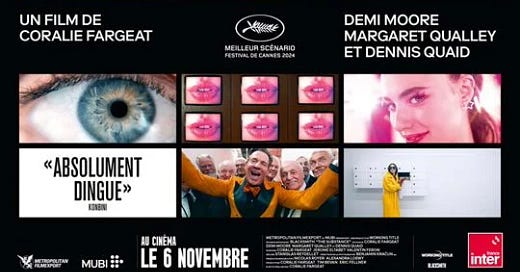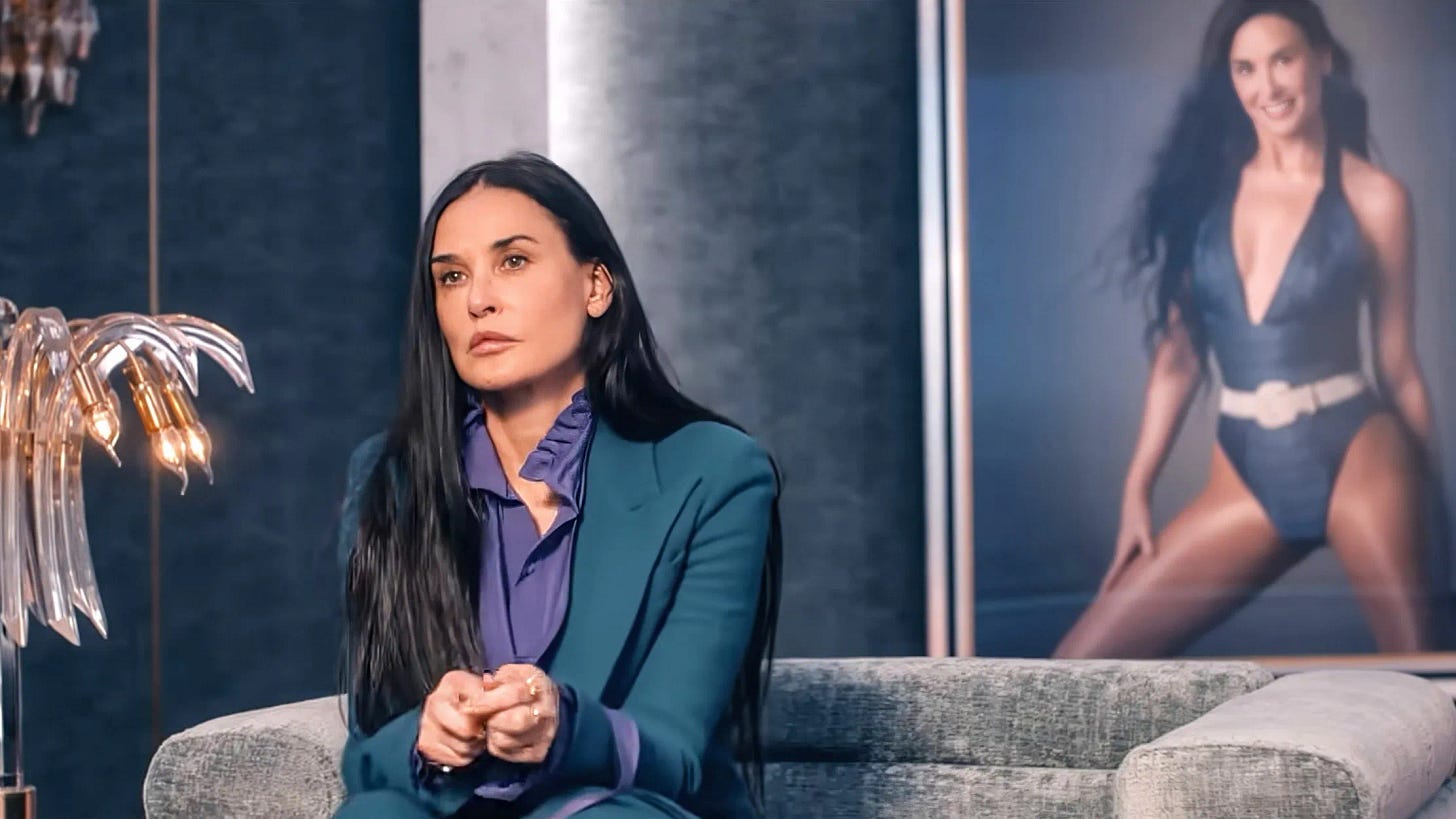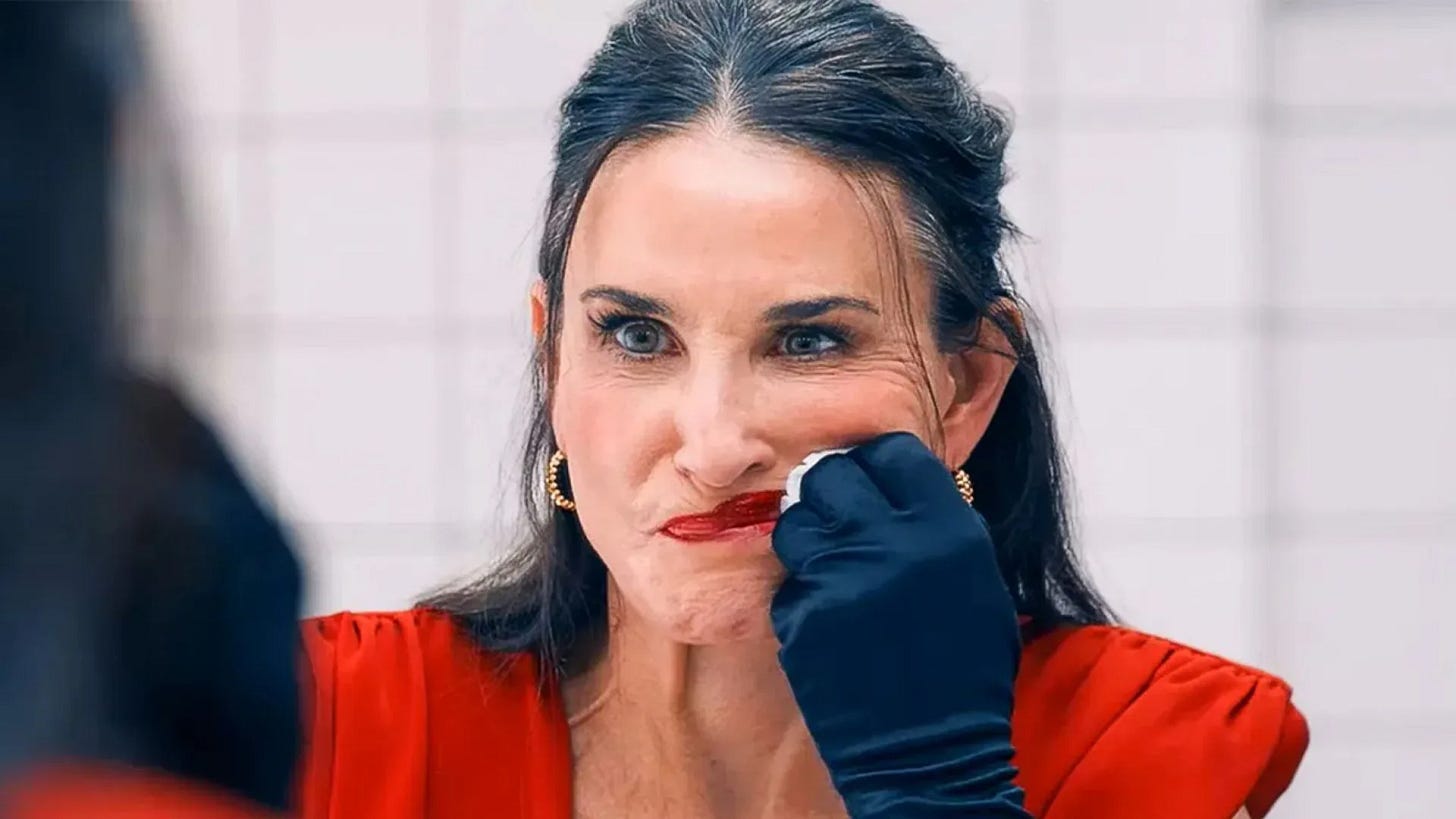I liked this movie. I would rather watch Death Becomes Her and I will not be watching it again, but I liked this movie. What I’m more sparkly eyed over is the use of color blocking, specifically through primary colors, and one thing about me… I’m always going to incorporate color theory and color psychology wherever I can. I’ve actually written many “The History of Insert-Color-Here in Fashion” pieces and can share them with you here if you’d like!
Anyway, let’s get into this freak show.
The Substance follows aerobics starlet, Elisabeth Sparkle, after she gets fired on her 50th birthday by her gross shrimp guzzling boss who I know smells like CVS cologne. She starts to spiral about her looks and her aging body, and after being distracted on her drive home from her solo birthday drinks, she gets into a car accident. As the doctor provides her with a clean bill of health, a young nurse gives her one last look over before slipping a USB for “The Substance” into her pocket, with a note telling her how it changed his life. Elisabeth watches the video describing a black market substance that will allow her to be a better version of herself. Finally succumbing to temptation, Elisabeth takes “The Substance” and Sue, a younger and “more perfect” version of herself, crawls out of her spine. Fun! The two have to switch bodies every seven days in order to keep the balance of things and make sure they can both live, but Sue gets too greedy in her fame and success and overstays her welcome. After running out of the fluid that is keeping her alive, Sue finally has to switch back with Elisabeth who finds herself turned into a very disfigured and aged human, who runs far too fast, in my opinion. Elisabeth decides to terminate her experience, but quickly craves admiration once more and tries to bring Sue back to life. Now the girls are both conscious and they are fighting!!! Sue kills Elisabeth, but as Elisabeth is “the matrix” and the only reason Sue is alive, her body starts to deteriorate. She tries to create a better version of herself by also taking “The Substance,” because she has a New Years Eve special she has to host, but instead births “Monstro Elisasue” who she tries to cover by putting on a mask, but the mask falls and she gets attacked and eventually sprays blood over everyone and everything, and that’s all you need to know.
Costumes for The Substance were done by Emmanuelle Youchnovski. I tried to look for anything she had said about her approach to the costume design, but came up painfully empty handed. I also tried finding a way to reach out which also did not manifest, so, it’s just me and my color psychology notes against the world.
However, before we get into the color theory of it all, I wanted to touch on the body horror and use of the grotesque, very briefly, because I would argue that that is part of the costume design in a sense. After all, we are all always performing.
Susan Sontag notes that the fetishization of youth is “the most enduring obsession of our culture.” Both Elisabeth and Sue’s decay embody the fragility of beauty ideals, and how in the pursuit of impossible standards they lose control of their bodies, suggesting that beauty’s allure is as much a trap as it is a privilege. The grotesque mutations of their bodies serve as a visual metaphor for the insidious nature of beauty culture and how it goes far beyond, “do what makes you happy.” In The Substance, horror emerges from the gradual loss of control, symbolizing how the relentless pursuit of perfection can instead lead to self-destruction. I also say this to bring up the fact that the use of color theory and all of these vibrant, saturated hues represents the allure of beauty ideals, juxtaposed with the muted, sickly tones of the characters deterioration.
Now, Elisabeth, our primary color queen. In color theory, triadic colors are often used to create harmony and make the overall image stand out. For us, the viewer, that works. It is incredibly eye catching against the Stanley Kubrick-esque backdrop. However for Elisabeth as a character, it does not. She’s stunning! A girl you don’t forget, and yet she remains unaware of the way she “stands out.” Something else to note about the use of primary colors is that they are the three colors mixed to get all other hues. This parallels Elisabeth’s being “the matrix” and how without her, Sue does not exist.
Naturally, we must begin with the yellow coat that quickly become a Halloween costume moodboard staple. The yellow coat is the only piece of clothing that is worn by both Elisabeth and Sue. Yes, Elisabeth does put on Sue’s dragon robe at one point, but I find that more as mockery than actual sharing of clothing. Anyway, if we look back to the beginning of the film, we see egg yolks in the beginning, and Elisabeth and Sue are two yolks from the same egg- they are one. There’s also the two yellow balls seen in the video Elisabeth watches about “The Subtance” that parallel that same way of thinking. The color yellow is often used as a warning of hazardous substances, but can also represent hope. Depending on who you ask, Elisabeth is ingesting a hazardous substance, and she has hope about what the outcome of doing so will entail. Yellow is often seen in spiritual imagery as well, and there is a bit of playing God going on here. To Elisabeth specifically, the yellow coat seems to act like an armor— a comfort blanket. As she becomes more vulnerable, the coat becomes tighter, the collar stands higher, and it’s her one consistency.
Blue is Elisabeth’s main color before taking “The Substance.” We see her wear a blue aerobics outfit, a blue backless velvet dress, and a blue pussybow blouse. While, yes, blue is a color that can represent calmness, it also can represent sadness and depression. It anchors her in a cold, contemplative reality where she is seeking something more. Blue is also known to suppress appetite because it is a color often associated with things that could be poisonous to the body, and well, “The Substance.” In Eastern culture, it can represent immortality, which aligns with taking “The Substance” and being young forever. There is also a very specific shot of her blue, backless dress that focuses on her spine and open back. Being that she wears it on her birthday, it’s very much giving “birthday suit” since that is where Sue moseyed on out of.
After taking “The Substance” we see Elisabeth wear a red suit and red gloves. Red can represent danger and anger and the kettle is definitely boiling at this point in the film. Red is also the color of the root chakra, which represents groundedness and survival— qualities that are now tainted by the hazardous nature of Elisabeth’s transformation. She is no longer a nourishing source of energy.
Then there’s Sue, who does sport some blues, purples, oranges, etc. but mainly focuses on pink. Pink is the diluted version of red and Sue is the diluted version of Elisabeth. This conveys a subtler power— a power that mirrors Elisabeth’s intense transformation but is more playful, flirtatious, and feminine. When we see gender reveals, there is often a focus on blue and pink, and so there is that association with the womb and innocence in the way that pink portrays the youthfulness that Elisabeth lacks. There is a Renaissance painting called “The Madonna of the Pinks” by Raphael, where the child is giving the Virgin Mary a pink flower. The pink was a symbol of marriage, showing a spiritual marriage between the mother and the child, in the same way that there is some kind of spiritual, if you will, connection between Sue and Elisabeth. There’s also the phrase, “in the pink” meaning in good health or in good condition, which is what Sue is meant to be.
We see some reptilian motifs throughout Sue’s wardrobe as well, like a snakeskin catsuit and a silk robe with an embroidered dragon. Sue essentially sheds Elisabeth’s skin as she comes out of her spine the same way a snake would. She is Elisabeth’s capacity for change, shedding layers of herself to reveal something new. In The Psychology of Fashion, Carolyn Mair writes, “Snakeskin evokes primal instincts and portrays a bold, unapologetic sexuality,” emphasizing Sue’s dominance over her form and her comfort in her own skin, which starkly contrasts Elisabeth’s more cautious self-presentation.
Throughout The Substance costumes reflect not only Elisabeth and Sue’s psychological states but also their physical transformations, using vibrant hues and tactile materials to emphasize their shared but fracturing existence. As the two fight for dominance, the costumes remind us that beauty and identity are performances, and, like “The Substance” itself, they demand a price.
Imagine the costume designer reads all this and just goes, yeah, I was just a really big fan of Pierpaolo’s Valentino.
TTYL!!!
xx









